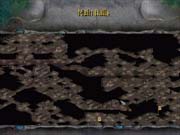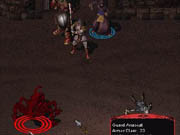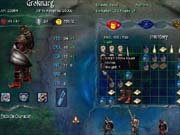Pool Of Radiance Ruins Of Myth Drannor
Pool of Radiance: Ruins of Myth Drannor Review
The game is primarily an uninspired dungeon crawl, burdened by repetitive gameplay, a cumbersome interface, and some serious technical bug.
While nearly early estimator role-playing games were essentially crude, unauthorized adaptations of pen-and-newspaper Dungeons & Dragons, computer gamers weren't granted the opportunity to play a sanctioned translation of D&D until the 1988 release of Puddle of Radiance. Pool of Radiance was an ambitious, pioneering game that offered an effective combination of beginning-person-perspective exploration and tactical combat from an isometric perspective. It spawned the acclaimed "golden box" series of D&D games, which is still mentioned reverentially by RPG fans. Given that pedigree, it's surprising that the design for its belated spin-off is and then lacking in appetite. Pool of Radiance: Ruins of Myth Drannor features some skilful graphics and a decent adaptation of D&D's plough-based tactical combat, but the game is primarily an uninspired dungeon crawl, burdened past repetitive gameplay, a cumbersome interface, and some serious technical issues.

Ruins of Myth Drannor doesn't try to provide an expansive gaming world or varied gameplay. Instead, as the name suggests, the game is almost entirely ready within the labyrinthine ruins of the ancient city of Myth Drannor, and gameplay primarily consists of tactical gainsay interrupted by brief spelunking interludes. Myth Drannor is one of the most famous cities in D&D'due south Forgotten Realms milieu, and early on in the game's pattern the developers indicated that they were going to comprise existing maps and other source material from tabletop D&D to flesh out environments. Those plans were either inverse or significantly reduced in telescopic, since the game'south dungeon layouts are simplistic and largely devoid of distinctive features. There are very few nonplayer characters to interact with, and no depth to your interactions with those characters. Since the skeletal plot is completely linear and there are no meaningful opportunities to role-play characters of varying alignments or motivations, the emphasis of the game is about exclusively on tactical combat.
Many RPGs are combat intensive, merely combat is virtually the entire focus of Ruins of Myth Drannor. Although this will disappoint those who were hoping for a more substantial RPG, at least the battles can be engaging, even if repetitive. While last year'southward Baldur's Gate II plucked a few elements from the new D&D 3rd Edition rules, Ruins of Myth Drannor is the outset game to attempt to comprehensively adapt those rules. The gainsay and movement aspects of the rules were adapted relatively faithfully, so you can maneuver your characters to flank opponents, charge distant enemies, or be positioned to make attacks of opportunity against nearby foes that try to cast spells. The turn-based nature of Ruins of Myth Drannor also lets you more effectively cast spells than you could in the frantic, dynamic existent-fourth dimension skirmishes of recent D&D games, and the game'southward interface highlights each spell's proposed surface area of effect to facilitate precise targeting. Still, the fights in Ruins of Myth Drannor lack the complexity of Baldur's Gate II's mage duels and the variety of tactical options offered past other turn-based combat games, such equally Jagged Alliance ii. You'll besides fight each of the game's various monster types hundreds of times, and at that place'southward little diverseness to these engagements, once you lot primary a few rudimentary tactical maneuvers.
The initial design for the game contemplated letting characters collaborate with a variety of objects in the gaming globe. Early press materials for the game promised that characters would be able to tip over tables, push button crates, block doors, climb objects, and otherwise interact with the environment to thwart opponents or proceeds tactical advantages. A multifariousness of objects did make it into the game, but y'all tin can't do annihilation with them other than nail them. Just different games such as Diablo that similarly stock their environments with breakable objects, in that location's almost never anything independent in the barrels, boxes, and tables scattered through the dungeon levels. All the same since your progress is dependent on finding a few central items, y'all'll likely be motivated by fear that you'll miss a vital item, or frustration when yous can't find a particular ane, to waste time fruitlessly smashing hundreds of hapless pieces of article of furniture.

There are other indications that propose the developers were either unsure of the type of game that they wanted to make or were unable to adequately test their ideas. Every bit in many hack-and-slash RPGs, your characters volition larn a mountain of gold and items, but that boodle is almost valueless in Ruins of Myth Drannor, since in that location's almost no opportunity to really spend your wealth. The dungeons are overflowing with healing potions and scrolls, and yet you tin just balance to immediately recover all hit points and spells, making the utility of those items questionable. The game fifty-fifty highlights when you can balance without any fright of pause, and a safe oasis is about e'er available every few steps. The ability to freely rest at almost whatever time also makes spellcasters far more powerful than in other D&D games, since at that place's no reason to conserve your bachelor spells when yous can easily recover them after every combat.
The game'due south menu-driven interface is cumbersome, at least until you lot assign hotkeys to each character's frequent deportment. For case, to use a magic item, you have to start either press "I" on your keyboard, or right-click on a graphic symbol to bring up a carte of items and then select the inventory tab, and then yous have to further select the magic tab to bring up a list of carried magic items, and finally select the desired item. As if that weren't burdensome enough, if you didn't use the same item in the previous turn, yous so have to repeat the exact same procedure a 2d fourth dimension earlier you tin can finally target the magical issue created past the detail. If you happen to inadvertently motility your mouse or release the push button prior to making your selection, which happens far likewise frequently as a event of the intermittent slowdowns the game suffers from, you'll have to repeat the selection procedure.
The interface is flawed in other ways also. You'll often come across inconsistencies between the feedback provided by the interface and the actual actions of your characters. Characters occasionally won't move to a location you designate, even though the game's interface indicates that the location is accessible. In the middle of a character's turn, the game will occasionally seem to change its mind about whether or not the character has a articulate line of sight to an opponent, preventing you from completing an attack with a ranged weapon or spell. Characters sometimes lose their power to attack by failing to take a direct path to a selected destination. The game'due south isometric perspective makes it difficult to move characters close plenty to, without inadvertently opening, doors or chests to search for traps. Since you tin can only motility either a unmarried character or the entire party, it's tedious to frequently change your germination or clear out the surface area about a doorway or by an object you doubtable is trapped. Your party members are required to remain in very close proximity to each other, which makes information technology incommunicable to scout or search unsafe locations or objects and makes multiplayer games wearisome for players not decision-making the party leader. You tin can elect to take your political party either walk or run, but the walking speed is then interminably slow that information technology's near unusable.

The 3rd Edition D&D rules are significantly dissimilar from their predecessors, and in many means the developers of Ruins of Myth Drannor did a decent task of adapting those rules. Large sections of the game's transmission, including almost all of the descriptions of skills, feats, and spells, are taken directly from the D&D Players' Handbook, highlighting the faithfulness of the adaptation of those aspects of the game. While some players will bemoan their inability to apply simulated die rolls to generate their characters, the point arrangement used by the game is specifically sanctioned by the D&D Dungeon Master'due south Guide. Weapon traits, including the new organization for calculating the likelihood of landing a critical hitting, were accurately imported from the tabletop rules. Spells were adapted particularly faithfully, and the graphical furnishings attached to some of the spells are hands the single best feature of the game. With a couple of very minor exceptions, instead of inventing their own spells, skills, or feats, the developers stuck exclusively to the cadre rules.
The game also perfectly adapts the new flexible multiclass rules, which mostly let you gain levels in unlike character classes without having to designate which class you want to accelerate in until y'all're ready to gain a level. Graphic symbol-level advancement is rapid under the tertiary Edition rules, at least relative to the older D&D rules, but because the developers elected to stick with experience betoken awards that are consistent with the rules, level advancement is ironically slower in Ruins of Myth Drannor than in nearly RPGs. Characters tin can reach up to level 16 in any character grade, and since that cap is level-based, it tin can be reached in more than one form, which is more relevant in multiplayer where you can proceed to have characters on randomly generated adventures.

Unfortunately, some of the compromises made by the developers in adapting the tertiary Edition rules dilute some of the master advantages of the revised rules. In pen-and-paper D&D, the 3rd Edition rules provide you lot with the ability to customize the development of your characters, past selecting special abilities (called feats) and skills, in a manner similar to the "perks and skills" system used by the Fallout games. Nether prior iterations of the D&D rules, in that location were few opportunities to meaningfully distinguish characters, and each character course and race was somewhat arbitrarily limited to sure development paths. For example, spellcasters could utilise only a scattering of basic weapons--just in 3rd Edition D&D, spellcasters can optionally use skill points to acquire expertise in swords, halberds, or any weapon. But in Ruins of Myth Drannor, you can't cull the skills and feats given to your characters, and equally a issue the developers have essentially reintroduced the rigid class restrictions imposed by the former rules and removed the ability to customize graphic symbol development. Spellcasters, clerics, and even rogues are express to using basic weaponry, which makes the Ruins of Myth Drannor arrangement even more punitive than the quondam tabletop D&D rules. Fifty-fifty worse, the only decent ranged weapon that such characters are normally entitled to apply, a crossbow, doesn't be in the game. You also have no control over the operation of some of the nigh interesting skills, such as a rogue's stealth abilities. Metamagic feats, which let spellcasters further personalize their magic, likewise aren't available. The handful of chosen skills for each character grade, and their ongoing development, often don't brand sense. Fighters are given the "concentration" skill that prevents spells, which they're unable to cast, from existence disrupted. Clerics focus their evolution points, and automatically choose a related feat, into "spellcraft," a completely worthless skill that lets characters identify what spells enemies are casting against them.
There are other notable variations from the core tertiary Edition rules. The developers didn't comprise D&D's traditional spellcasting system, which requires characters to select and memorize their spells in advance of casting them, and instead gave all spellcasters tertiary Edition'southward new sorcerer class'southward ability to designate their spells at the fourth dimension of casting. Bards, druids, and traditional wizards aren't available as grapheme classes, and gnomes aren't available equally a character race. Character alignment is meaningless in the game, other than every bit a prerequisite for sure classes. The developers have justified these omissions on the grounds that they inherited some design decisions from founders of the project who didn't remain on the development team, as a event of several recent corporate reorganizations. While some gamers may exist sympathetic to the justifications for the omissions, the game would undoubtedly exist better if the compromises hadn't been made. Several aspects of the game just seem to be missing, such as the power to create female characters for each race.

Aside from the points already mentioned, there are other examples that advise that the developers were unable to fulfill their intentions or otherwise overlooked gameplay remainder issues. While it'southward admirable that the developers gave spells the aforementioned durations that they are given in the tabletop D&D rules, the value of having a "charm monster" spell last for a full 24-hour interval is completely eliminated by requiring you to remain in combat mode while the spell is in effect. Charmed creatures won't even follow your party, and since it's impossible to ever retreat from boxing, you're forced to heartlessly slay your new ally to proceed playing the game. Since some graphic symbol classes had more than of their special tabletop D&D class abilities included, those characters are more than powerful than others. Because the developers didn't contain dual weapon wielding, rangers are much weaker than any other type of fighter form. Rogues proceeds feel points considerably more than rapidly than other classes considering they individually gain experience points for disarming traps. Spells up to eighth level are incorporated, simply clerics are given only one spell for each of their concluding iii levels, while sorcerers are given a total of x. The game's flexible multiclassing system somewhat alleviates these problems, just the relative strengths of the classes are unbalanced.
Perhaps worst of all, the game shipped with some egregious technical bug. While there aren't necessarily a smashing number of bugs, the ones that practice exist are peculiarly serious. At one point the game consistently crashed when it saved, which required the game to exist reinstalled. Even if you designate a different directory when running the game's installation utility, the game will always be installed to your program files directory on your C: difficult drive. While we were able to uninstall, and reinstall, the plan uneventfully, others have reported that uninstalling the game deleted their hard drives equally a upshot of this glitch. Gameplay frequently slowed downwardly to a snail'due south pace, suggesting the game suffers from retention leaks or is otherwise incompatible with certain hardware. There are too reports in newsgroups and on message boards indicating that some retail packages of the game shipped with missing discs.

The game features painted backgrounds like those in the BioWare Infinity Engine D&D games, but the background graphics aren't nearly equally detailed or interesting as in those games. The 3D character and monster graphics look great, however, and spell furnishings are outstanding. Creatures are well animated, and larger monsters such as the scorpion-similar arraccats look especially adept. On the other manus, the music and audio effects are by and large forgettable. Some of the music in the game is very similar in quality and manner to the melodies provided with SSI's original series of D&D games, which isn't a adept thing even for nostalgic fans, given the age of those games. The game is very hard at the offset, since first-level characters can't have much damage and your party initially consists of just four characters, simply once your characters accept gained a level or two and acquired some magical equipment, the game becomes much easier and more interesting. The multiplayer game won't be as much fun for those who aren't controlling the party leader, since other players can't e'er control their own characters and can never stray far from the political party leader, just the random dungeons do give the game adept replayability.
The cadre combat can be enjoyable and gets more interesting as higher-level spells became available--information technology never gets old using chain lightning and fireball spells to clear out a room. Still even if y'all're just looking for a dungeon crawl to hack and slash your mode through and aren't looking for a deeper RPG, you're unlikely to exist entirely satisfied with Ruins of Myth Drannor. D&D fans may relish experiencing some aspects of the game's rendition of 3rd Edition D&D combat, but they're besides likely to exist frustrated past some of the game's compromises. And those expecting Ruins of Myth Drannor to exist an ballsy game of comparable scope to Baldur's Gate 2 will be sorely disappointed. While it's refreshing to see a D&D game by a publisher other than Blackness Island Studios, Ruins of Myth Drannor doesn't measure upwardly to recent D&D role-playing games, or even its predecessor.
Pool Of Radiance Ruins Of Myth Drannor,
Source: https://www.gamespot.com/reviews/pool-of-radiance-ruins-of-myth-drannor-review/1900-2815696/
Posted by: levyunat1969.blogspot.com


0 Response to "Pool Of Radiance Ruins Of Myth Drannor"
Post a Comment